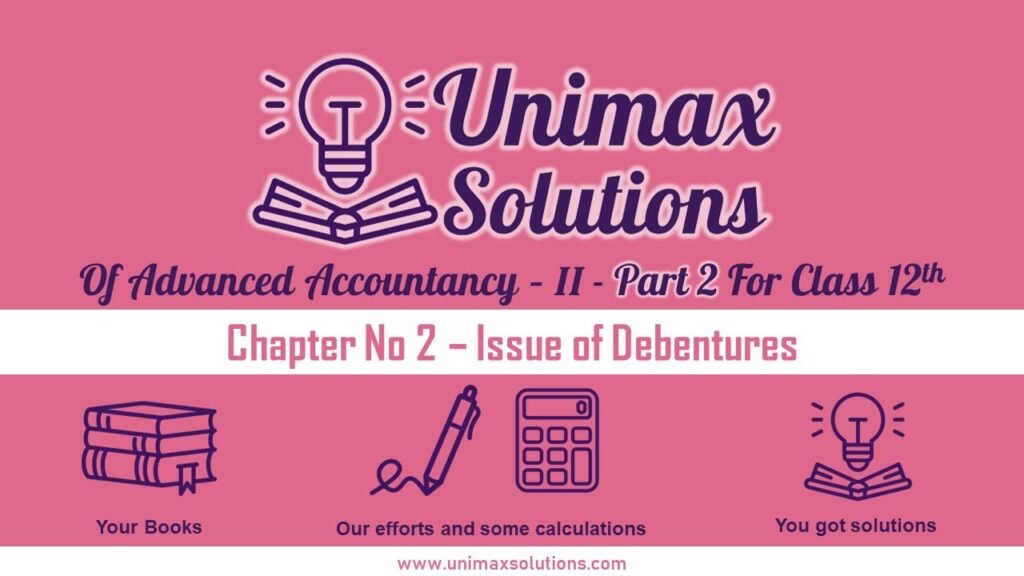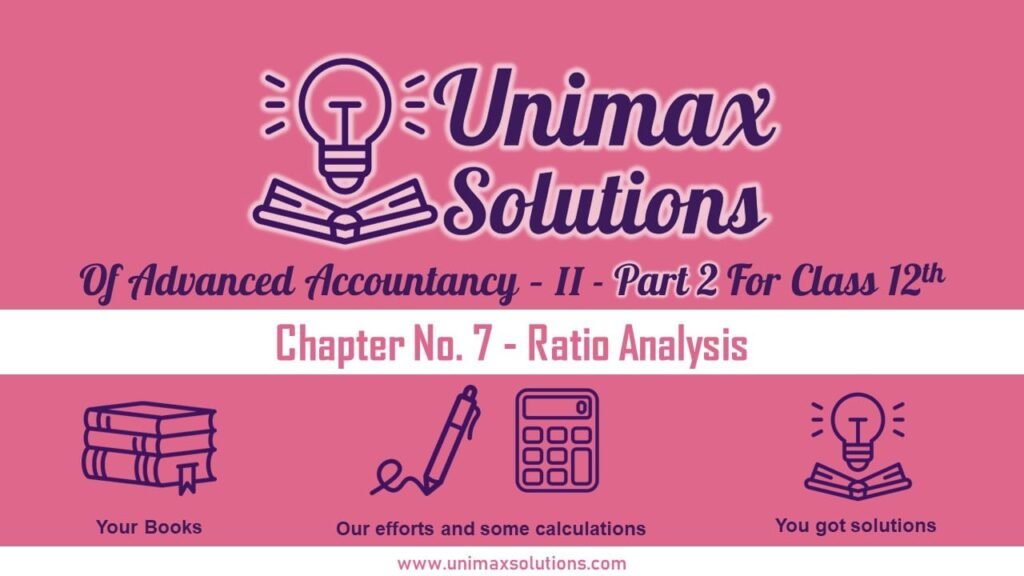
Advertisement
In the article of Solution of Advanced Accountancy II Part 1 by Unimax Publications for PSEB Students of Class 12, We have solved the Advanced Accountancy II Part 2 by Unimax Publications for Class 12. These books are covered by the syllabus provided by the Punjab School Education Board(PSEB):
Solution of Advanced Accountancy II Part 2 by Unimax Publications Class 12:
The Chapter-wise Solution of Advanced Accountancy II Part 1 Class 12 by Unimax is shown below:
In this chapter students delve into the topic of Company Accounts, specifically focusing on Share Capital. This chapter introduces students to the concept of share capital and its significance in the functioning of a company. Students will learn about the different types of shares, such as equity shares and preference shares, and the various methods of issuing shares. They will gain insights into the accounting treatment of share capital, including the preparation of share capital accounts, the calculation of calls-in-advance and calls-in-arrears, and the treatment of forfeited shares. By studying comprehensive examples and exercises, this chapter aims to provide students with a thorough understanding of the accounting procedures and calculations related to company accounts and share capital.
Chapter No. 2 – Issue of Debentures:
Chapter 2 of Advanced Accountancy II Part 2 for Class 12 by Unimax focuses on the topic of the Issue of Debentures. This chapter explores the concept of debentures, which are long-term debt instruments issued by companies to raise funds. Students will learn about the various types of debentures, such as redeemable and irredeemable debentures, and the methods of issuing debentures, including at par, at a premium, and at a discount. They will gain insights into the accounting treatment of debentures, including the preparation of debenture redemption reserve, the calculation of interest on debentures, and the redemption of debentures. By studying comprehensive examples and exercises, this chapter aims to equip students with the knowledge and skills necessary to understand the accounting procedures and calculations related to the issue of debentures.
Chapter 3 of Advanced Accountancy II Part 2 for Class 12 by Unimax focuses on the topic of the Redemption of Debentures. This chapter delves into the process of redeeming debentures, which involves repaying the principal amount to the debenture holders. Students will learn about the different methods of redemption, such as redemption at par, premium, and discount, and the accounting treatment involved in each method. They will gain insights into the preparation of the Debenture Redemption Reserve (DRR) account, the calculation of interest on debentures, and the journal entries for the redemption of debentures. By studying comprehensive examples and exercises, this chapter aims to provide students with a thorough understanding of the accounting procedures and calculations related to the redemption of debentures.
Chapter No. 4 – Financial Statements of a Company (Balance Sheet Only):
This Chapter concentrates on the preparation of Financial Statements of a Company, specifically the Balance Sheet. This chapter introduces students to the concept of a balance sheet and its importance in presenting the financial position of a company. Students will learn about the different components of a balance sheet, including assets, liabilities, and shareholders’ equity. They will gain insights into the classification and valuation of assets and liabilities, the preparation of various schedules and notes to the accounts, and the presentation of a balance sheet in the prescribed format. By studying comprehensive examples and exercises, this chapter aims to equip students with the knowledge and skills necessary to understand the preparation and presentation of a company’s balance sheet.
Financial statement analysis plays a vital role in understanding the financial health and performance of a company. It involves the systematic examination of a company’s financial statements, such as the income statement, balance sheet, and cash flow statement, to assess its profitability, liquidity, solvency, and overall financial stability. By utilizing various tools and techniques, such as ratio analysis, trend analysis, and benchmarking, financial statement analysis provides valuable insights into a company’s strengths, weaknesses, and prospects. It helps investors, stakeholders, and management make informed decisions, identify potential risks, and devise strategies for growth and improvement. With its ability to uncover key financial indicators and trends, financial statement analysis serves as a crucial tool for evaluating the performance and financial viability of a company.
Advertisement
Chapter No. 6 – Tools/Methods of Financial Analysis:
Chapter 6 of Advanced Accountancy II Part 2 for Class 12 by Unimax focuses on the Tools/Methods of Financial Analysis. In this chapter, students explore various tools and techniques used to analyze the financial performance and position of a company. Students will learn about key financial ratios and their significance in evaluating a company’s liquidity, profitability, efficiency, and solvency. They will gain insights into ratio analysis, common-size statements, comparative statements, and trend analysis. By studying comprehensive examples and exercises, this chapter aims to provide students with the knowledge and skills necessary to interpret and analyze financial data using different tools and methods.
This Chapter dives deeper into the topic of Ratio Analysis. Building upon the previous chapter, this chapter focuses specifically on ratio analysis as a tool for evaluating a company’s financial performance. Students will learn about different categories of ratios, including liquidity ratios, profitability ratios, activity ratios, and solvency ratios. They will gain insights into the calculation, interpretation, and significance of various ratios, such as the current ratio, gross profit ratio, return on investment (ROI), and debt-equity ratio. By studying comprehensive examples and exercises, this chapter aims to equip students with the knowledge and skills necessary to perform ratio analysis and make informed decisions based on the results.
Chapter No. 8 – Cash Flow Statement:
Chapter 8 of Advanced Accountancy II Part 2 for Class 12 by Unimax focuses on the preparation and analysis of the Cash Flow Statement. This chapter introduces students to the concept and importance of a Cash Flow Statement, which provides information about the cash inflows and outflows of a company during a specific period. Students will learn about the classification of cash flows into operating, investing, and financing activities. They will gain insights into the preparation of a Cash Flow Statement using the direct and indirect methods, as well as the interpretation and analysis of the statement. By studying comprehensive examples and exercises, this chapter aims to provide students with a thorough understanding of the preparation, interpretation, and analysis of the Cash Flow Statement as a vital tool for assessing a company’s liquidity and cash management.
Advertisement









